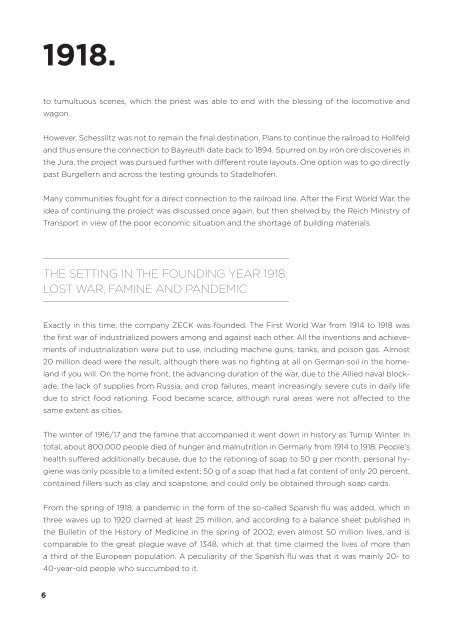ZECK - THE STORY
1918 - 2023 The Company Chronicle for the 105th Anniversary.
1918 - 2023 The Company Chronicle for the 105th Anniversary.
Create successful ePaper yourself
Turn your PDF publications into a flip-book with our unique Google optimized e-Paper software.
1918.<br />
to tumultuous scenes, which the priest was able to end with the blessing of the locomotive and<br />
wagon.<br />
However, Schesslitz was not to remain the final destination. Plans to continue the railroad to Hollfeld<br />
and thus ensure the connection to Bayreuth date back to 1894. Spurred on by iron ore discoveries in<br />
the Jura, the project was pursued further with different route layouts. One option was to go directly<br />
past Burgellern and across the testing grounds to Stadelhofen.<br />
Many communities fought for a direct connection to the railroad line. After the First World War, the<br />
idea of continuing the project was discussed once again, but then shelved by the Reich Ministry of<br />
Transport in view of the poor economic situation and the shortage of building materials.<br />
<strong>THE</strong> SETTING IN <strong>THE</strong> FOUNDING YEAR 1918:<br />
LOST WAR, FAMINE AND PANDEMIC<br />
Exactly in this time, the company <strong>ZECK</strong> was founded. The First World War from 1914 to 1918 was<br />
the first war of industrialized powers among and against each other. All the inventions and achievements<br />
of industrialization were put to use, including machine guns, tanks, and poison gas. Almost<br />
20 million dead were the result, although there was no fighting at all on German soil in the homeland<br />
if you will. On the home front, the advancing duration of the war, due to the Allied naval blockade,<br />
the lack of supplies from Russia, and crop failures, meant increasingly severe cuts in daily life<br />
due to strict food rationing. Food became scarce, although rural areas were not affected to the<br />
same extent as cities.<br />
The winter of 1916/17 and the famine that accompanied it went down in history as Turnip Winter. In<br />
total, about 800,000 people died of hunger and malnutrition in Germany from 1914 to 1918. People's<br />
health suffered additionally because, due to the rationing of soap to 50 g per month, personal hygiene<br />
was only possible to a limited extent; 50 g of a soap that had a fat content of only 20 percent,<br />
contained fillers such as clay and soapstone, and could only be obtained through soap cards.<br />
From the spring of 1918, a pandemic in the form of the so-called Spanish flu was added, which in<br />
three waves up to 1920 claimed at least 25 million, and according to a balance sheet published in<br />
the Bulletin of the History of Medicine in the spring of 2002, even almost 50 million lives, and is<br />
comparable to the great plague wave of 1348, which at that time claimed the lives of more than<br />
a third of the European population. A peculiarity of the Spanish flu was that it was mainly 20- to<br />
40-year-old people who succumbed to it.<br />
6















